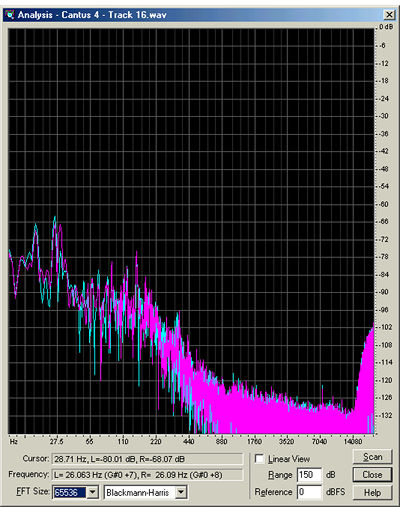| Columns Retired Columns & Blogs |
One by One: the Cantus Recording Project Capturing Cantus part 3
We used two strategies to resolve the situation. First, we increased the level of the quiet, contemplative tracks by 6dB. This may sound extreme on paper, but it didn't sound wrong in the mix, and didn't result in an unnatural "gear-change" effect. Second, I isolated each of the 12 railroad-spike transients by creating a very short crossfade before and after each one with the Sonic Solutions and reduced the level of just the initial transient by another 6dB. Somewhat to our surprise, this was completely inaudible, and got us back another bit's worth of dynamic range. (The human ear judges loudness by the average level, not by the peak level.)
Now it was time to address the hum. The DSP supplied with the Sonic Solutions Sonic System includes some versatile parametric equalization. After some experimentation, I applied a pretty fierce, -30dB notch at 120Hz, just a couple of hertz wide, to the omnis alone. This effectively killed the higher-frequency component of the noise, but the associated phase shift didn't appear to affect the perceived soundstaging. I then tried high-pass-filtering the low-frequency components. While this did knock out the residual hum, it diminished the sound's "magic." I therefore left the recording's low end wide open. Fig.2 shows a spectral analysis of the final noise floor. The low-frequency components lie around 65dB down from the recording's peak level. If they are still bothersome on your system, then your subwoofer is probably turned up too high.

Fig.2 Spectral analysis of background noise on final master after noiseshaping to 16 bits (6dB/vertical div.). The rise in the noisefloor above 18kHz is due to the POW-R redithering algorithm.
Finally, I applied some mild EQ to correct for the microphones' departures from a truly flat response. Using parametric EQ supplied by the Z-Systems rdp-1 I had purchased a few years back, I shelved down just the omnis' high frequencies by 3dB and applied a broad, shallow boost to the cardioids' lower midrange.
The optimal amount of EQ was quite critical. At the correct amount of lower-midrange boost, for example, you could hear into the arrangements and enjoy the interplay between the inner voices, just as you could in real life. Just 0.5dB less boost and those inner voices became obscured; 0.5dB too much boost and the basses started to sound artificial, too "fruity."
We did a lot of experimentation, and even after Erick and Michael flew back to Minnesota, we weren't quite sure of the exact equalization settings. I therefore prepared a number of CD-Rs, each with a slightly different EQ, and we spent most of the month of August playing them on as many different systems as possible. Finally, we all settled on the option that preserved more of the magic we had experienced in March. That version—burned onto CD-R in real time, of course, and noise-shaped to the CD's 16 bits using the rdp-1's POW-R redithering algorithm—was the one that went off to the CD plant.
High-end CD sound: Producing a recording involves both art and artifice. The trick for those involved with the artifice of recording is not to do anything that interferes with the art of the musicians. With almost all the Stereophile recordings, I have minimized this risk by using purist miking techniques and inherently good-sounding halls. But with this new Cantus CD, a strictly purist approach would not have best served the music. Artifice it would have to be.
There is a loudness level above which many commercial recordings fall apart. Though you may want to turn up the volume, other than the "joins" in the sound—the imperfections of the production process—there is nothing more to be heard. But a true high-end recording should reward the listener by offering more and more detail as the volume control is advanced, until the listener's system or ears run out of loudness capability.
I believe we achieved this goal with Let Your Voice Be Heard. While a good deal of artifice was involved in its production, that artifice was employed to produce what I believe to be the true sound of Cantus in that Minnesota concert hall.
Since the disc was mastered, I have listened to it on systems ranging from the awesome Mark Levinson-driven Wilson Audio WAMMs in Dave Wilson's music room in Utah, through the ultra-resolving Avalon Eclipses in Ayre Acoustics' dedicated room in Boulder, to Stereophile copy editor Richard Lehnert's modest Vandersteen 2Ce-based system in Santa Fe, and even the modest desk system I have in my New York office, based on Blueroom Minipod speakers driven by the Yamaha @PET receiver I reviewed in December 1999. Whether it was the sound of the effortlessly held long chords at the prolonged fadeout of the Mandarin "K'ang Ting," achieved with circular breathing, or the climactic throwing down of the slaves' chains in "Rainbow," or the vocal imitation of traditional Venezuelan strummed instruments in "Mata del Anima Sola," or the new life breathed into "Danny Boy," "She Moved Through the Fair," and "Loch Lomond" by Cantus' arrangements, or the hushed mystery of "Shenandoah," or the joyously unrestrained vamping on "One by One"—in every case, the sheer beauty of unaccompanied male singing voices, the art of 12 professional singers, proved overwhelming on every system on which I auditioned the CD.
Yes, I am biased. There's six months of my life invested in the 64 minutes and 20 seconds of music on this CD. So check out the CD for yourself. Let Your Voice Be Heard can be purchased from Acoustic Sounds, or from our secure " Recordings" page.—John Atkinson
- Log in or register to post comments




































